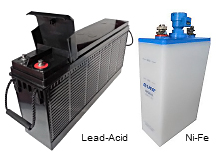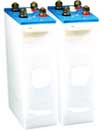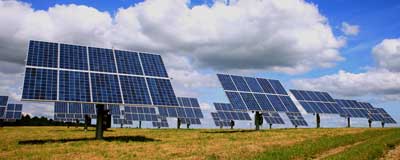

- Introduction
- NiFe-S Battery List
- Photovoltaic System
- NiFe-S Battery Benefits
- Compare VRLA and NiFe-S
About Nickel-Iron Solar Batteries
Nowadays great importance is attached in more and more countries to environmental protection and advocating adopting green energies. Q-Lite Nickel-Iron (Ni-Fe) batteries, with its high reliability, long service life, lower cost, pollution free and other strong features, are gradually replacing lead-acid batteries for many a wide range of applications, especially for solar PV and renewable energy and power systems.
Q-Lite NiFe-S Solar batteries are specially designed and manufactured for solar PV and renewable energy applications under critical and rough circumstances, which refer to low operation cost, low self-discharge, , long cycle life, environmental friendliness, etc; also the batteries are capable of withstanding deep discharge, wide temperature variation, mechanical & electrical abuses and still generate excellent and reliable performance over a long period of time.
NiFe-S solar batteries are suitable for all solar photovoltaic power systems. They are widely used as storage power supply for solar photovoltaic system, offshore oil platforms, railway transportation, traffic lighting and , signaling, faraway BTS station, cathodic protection for pipelines and radio navigation system. The service life of NiFe-S solar batteries is expected to be longer than 20 years with correct handling instructions and recommendations by manufacturer.
Battery unique features include a steel frame with welded plates, shock-resistant polypropylene or MBS casing material and excellent flame arresting flip-top vent. In addition, there is a big reserve of flooded electrolyte, which prolongs the topping-up interval period. With strong design and advanced manufacturing methods, NiFe-S solar batteries are particularly suitable for remote and isolated locations and require minimal maintenance.

About Photovoltaic Systems
The power generated by solar photovoltaic systems is widely used for various applications, such as pumping water, indoor lighting, power supply for a microwave tower on top of mountains, etc. A general solar photovoltaic system is ideal for site and unmanned operation due to easy installation and high reliabilities.

Photovoltaic Applications
| Navigations Aids | Telecommunication Systems |
* Remote lighthouses * Beacons * Offshore |
* Base Stations * Emergency Telephone Posts |
| Railway and Light Trains | Oil and Gas Fields |
| * Crossing Gates * Lighting and Signaling |
* Emergency Lighting on offshore platforms * Cathodic Protection for Pipelines |
| Utilities | |
| * Electric Power Supply for Remote Areas / islands |
About Benefits of NiFe-Solar Batteries
* Long cycle life (maximum service life target 20 years plus with correct operations)
* Wide operating temperature range
* Low maintenance
* High resistance to mechanical and electrical abuse
* Low transportation and installation cost

Characteristics Comparison Table
Item |
Lead Acid Cell |
NiFe-S Cell |
Nominal Voltage |
2V |
1.2V |
Float Charge Voltage |
2.23/cell ~2.3V/cell |
1.45V/cell~1.50V/cell |
Temperature makeup in float charge |
-3mV /℃•cell |
-3mV /℃•cell |
Operating Voltage |
Average |
Good |
Standard charge and discharge current |
0.1C10A |
0.25C5A |
High rate discharge performance |
Poor |
Good |
Overcharge performance |
Poor |
Good |
Over discharge performance |
Extremely poor |
Good |
Effect form from floating charge voltage |
When the charge voltage exceeds 2.35V /cell, the service life of VRLA cell will be reduced by 1/2 for every 0.1V/cell increase. |
Not affected |
Operation Life |
3-5-8 years |
20 years |
Storage Life |
2 years |
4 years |
High temperature performance |
When the ambient temperature exceeds to 50℃, there is capacity decrease risen from reduction of t charge acceptance performance, which significantly impact the service life of VRLA cells. |
Not affected |
Low temperature performance |
Huge effect on the service life of VRLA cell |
Little effect on the service life of NF-S series Ni-Fe cell |
Thermal danger if shorted |
Yes |
No |
Premature Capacity loss |
Yes |
No |
Environmentally friendly |
No |
Yes |
Cost Comparison Table on VRLA and NiFe-S Cells

Cost Effectiveness
There are three cost calculation concerns regarding the cost of a battery system:
* Initial investment, i.e. cost of purchases, spares, tools and installation.
* Maintenance cost, i.e. unexpected and expensive downtime cost.
* Replacement cost, i.e. dismantling, shipping, disposal and administrative cost.
VRLA Battery
In case of lead acid batter application, this can also include frequent requirement and all costs associated with an unexpected battery failure.
Ni-Fe Batteries
NiFe cells may cost more than lead-acid ones for the stage of initial investment alone. As for stand-by, like solar photovoltaic applications with large capital investment installed in remote locations, maintenance reliability and replacement cost factors can greatly outweigh the initial cost of the battery.
The performance of Ni-Fe cells are similar to that of Ni-Cd cells. In addition, Ni-Fe cells are pollution-free. Future maintenance requirement and life cycle costs are the main factors to be considered when making a cost effectiveness calculation. Considering the extra costs of sudden or premature failure of Lead acid batteries, Ni-Cd and Ni-Fe batteries are cheaper in the long-term.
Prismatic NiFe-S Battery Specifications (Pocket Technology)
| Model No. | Nominal Volt |
Rated C5 | Max. Weight |
Dimensions (mm) | Terminal Thread |
Electrolyte Volume |
Container Material |
||
|---|---|---|---|---|---|---|---|---|---|
| V | AH | kg | Height | Width | Thickness | L | |||
| NF10-S | 1.2 | 10 | 0.8 | 138 | 84 | 38 | M6 | 0.2 | MBS or PP |
| NF20-S | 1.2 | 20 | 1.2 | 220 | 113 | 32 | M6 | 0.3 | MBS or PP |
| NF30-S | 1.2 | 30 | 2.8 | 245 | 134 | 68 | M10 X 1 | 0.8 | MBS or PP |
| NF40-S | 1.2 | 40 | 3.0 | 245 | 134 | 68 | M10 X 1 | 0.8 | MBS or PP |
| NF50-S | 1.2 | 50 | 3.0 | 245 | 134 | 68 | M10 X 1 | 0.7 | MBS or PP |
| NF60-S | 1.2 | 60 | 4.2 | 285 | 134 | 70 | M16 | 0.9 | MBS or PP |
| NF70-S | 1.2 | 70 | 5.6 | 365 | 141 | 80 | M10 X 1 | 1.8 | MBS or PP |
| NF80-S | 1.2 | 80 | 5.8 | 365 | 141 | 80 | M10 X 1 | 1.7 | MBS or PP |
| NF100-S | 1.2 | 100 | 6.2 | 365 | 141 | 80 | M10 X 1 | 1.6 | MBS or PP |
| NF120-S | 1.2 | 120 | 6.4 | 365 | 141 | 80 | M10 X 1 | 1.4 | MBS or PP |
| NF150-S | 1.2 | 150 | 9.0 | 345 | 164 | 106 | M20 | 2.5 | MBS or PP |
| NF200-S | 1.2 | 200 | 10.0 | 345 | 164 | 106 | M20 | 1.8 | MBS or PP |
| NF250-S | 1.2 | 250 | 18.5 | 425 | 276 | 138 | M16 X 2 | 4.6 | PP |
| NF300-S | 1.2 | 300 | 21.5 | 450 | 276 | 138 | M16 X 2 | 4.2 | MBS or PP |
| NF350-S | 1.2 | 350 | 22.5 | 450 | 276 | 138 | M16 X 2 | 4.0 | MBS or PP |
| NF400-S | 1.2 | 400 | 23.5 | 490 | 276 | 138 | M16 X 2 | 4.3 | PP |
| NF500-S | 1.2 | 500 | 26.0 | 490 | 276 | 138 | M16 X 2 | 4.7 | PP |
| NF600-S | 1.2 | 600 | 38.0 | 510 | 291 | 176 | M20 X 2 | 8.7 | MBS or PP |
| NF700-S | 1.2 | 700 | 39.0 | 510 | 291 | 176 | M20 X 2 | 8.4 | MBS or PP |
| NF800-S | 1.2 | 800 | 60.0 | 570 | 398 | 186 | M20 X 3 | 17.2 | MBS or PP |
| NF900-S | 1.2 | 900 | 61.0 | 570 | 398 | 186 | M20 X 3 | 15.6 | MBS or PP |
| NF1000-S | 1.2 | 1000 | 62.0 | 570 | 398 | 186 | M20 X 3 | 15.0 | MBS or PP |
|
|||||||||
Copyright 2006-2012 @ Q-Lite Industrial Limited
Unit 1402, 14/F, Shenzhen Development Centre, 2010 Ren Min Road (S), Luo Hu District, Shenzhen 518001 China
Tel: +86-755-8220 9288 | Fax: +86-755-8222 4402 | Email: q-lite@q-liteindustrial.com